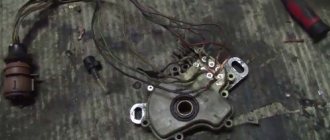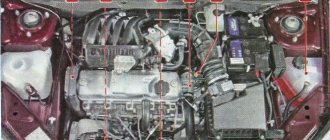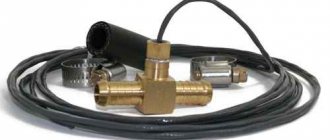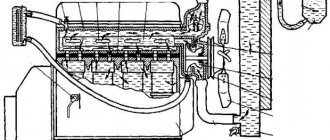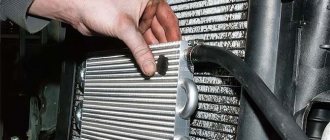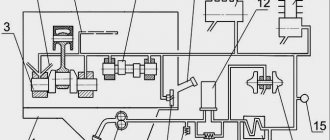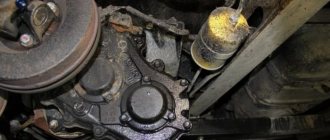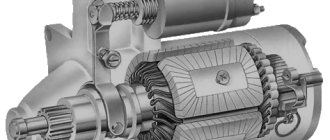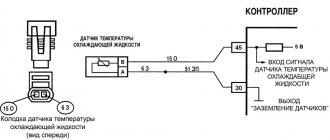Types of automatic transmission selectors
What is an automatic transmission selector and where is it located? Externally, the selector resembles a gear shift lever in a manual transmission with additional buttons. The automatic transmission gear selector has no lateral movement left/right; it can only move up/down.
Depending on the design of the control lever and the interior of the cabin, manufacturers place the gear shift lever in different places. According to their location, automatic transmission selectors are divided into the following types:
- Steering column type.
- Push-button located on the instrument panel.
- Floor.
Range D (Drive) is the main mode for moving forward.
This mode performs automatic sequential gear shifting (in this mode, all gears are usually involved except for upshifts). This mode is recommended under normal driving conditions. Range 3 (Number 3 on some types of automatic transmission) - the first three gears are engaged while driving. This mode is active, it is great for city driving, and turns off when the ignition is turned off. Especially at high operating speeds of the automatic transmission, it will not be possible to save fuel; this mode does not allow the torque converter clutch to be repeatedly locked and unlocked in rough city driving conditions (no more than 80 km/h), and is also partially blocked when switching to higher gears. Most suitable for driving when frequent stops are inevitable and for driving on roads with ups and downs. Engine braking is possible in this mode. Range 2 (Number 2 on automatic transmission) - in this mode, driving is only allowed in second and first gear. Most suitable for use on winding mountain roads. Switching to fourth and third gear is prohibited. Range 1 (L or Low) - low gear. In this mode, driving is only allowed in first gear. The traction capabilities of the engine in this range are realized to the maximum, since the torque transmitted to the wheels only in first gear is maximum. Engine braking is especially effective in this mode. Driving on steep descents and ascents must be done in first gear.
Overdrive (O/D)
Some automatic transmissions have a mode in which automatic upshifting is possible. The O/D (Overdrive) button is used to activate this automatic transmission mode. Its recessed position when the Drive mode is on allows you to switch to a higher gear. If you release this button, switching to the last gear will again become impossible. The O/D OFF indicator indicates the status of the control system. If the indicator is on, then using the Overdrive mode is impossible, but otherwise there is such a possibility.
It is recommended to use overdrive mainly on the highway for more economical and measured movement. Interestingly, some four-speed automatic transmissions (for example, (Toyota)aisin 241e) can disable 4th gear with gear ratio 1, which is not an overdrive!
One of the differences between an automatic transmission and a manual transmission is the inability to perform engine braking in each mode. In overrunning clutches, in modes that do not allow engine braking, the transmission slips and the car coasts. And when driver position 1 is selected, engine braking is applied in first gear. In the first gear in position D, such braking is impossible.
Features of the location of the automatic transmission selector
Convenient placement of the device under the steering column allows you to change gears without interference. Thanks to this interior design, there is an additional opportunity to use a solid seat in front, where a third passenger can fit. Similar designs were widely used in American-made cars at the end of the last century.
Push-button selectors were actively used in cars equipped with high-slung seats. In the fifties, such selectors were very popular and were installed in automatic machines of minibuses, minivans, jeeps and other models of that time. The main manufacturers of cars with push-button selector for automatic transmissions at that time were such well-known companies as Chrysler, Honda and some Japanese brands.
Modern vehicles manufactured in Europe and Japan are most often equipped with floor-mounted automatic gearshift levers. Here, the selectors are located in the middle of the cabin between the driver's seat and the front passenger seat.
How to shift gears on an automatic transmission
So, in our previous article we looked at how to engage reverse gear on a manual transmission, as well as how to correctly shift gears on a manual transmission. Now let's look at the automatic transmission.
First of all, there are several types of automatic transmissions: “classic” hydromechanical automatic transmission, CVT, and also robotic gearbox. It should be noted that although these types of “automatic machines” differ from each other structurally, they are functionally similar and have similar basic operating modes.
Among these main modes are:
- R- parking, parking;
- R - reverse gear;
- N-neutral;
- D - drive, forward movement;
- M - manual control mode;
Park mode allows you to start the engine, after which the engine idles (for example, during warm-up). It is also recommended to leave the car parked in this mode.
It is noteworthy that after turning on “P” the automatic transmission shaft locking is also activated. This blocking prevents the car from rolling and is an additional “insurance”.
Mode “R” is responsible for reverse gear and is activated only after the car has come to a complete stop. Ignoring this rule may cause serious damage to the gearbox.
The “N” mode, unlike the “P” mode, allows you to separate the transmission and the engine, and this mode does not have any additional locks (as in the case of “parking”).
However, unlike “mechanics” and some individual types of robotic gearboxes (for example, AMT), during a short stop with the internal combustion engine running, there is no need to switch to neutral. In fact, “neutral” on an automatic transmission is only needed for towing the car in the event of a breakdown (if the manufacturer has provided for such a possibility), and also as a service mode.
You can also turn on the “N” mode in a traffic jam, when the car has been standing for a long time (more than 10 minutes) and the engine is running, but you need to remember that in this case you need to additionally use the handbrake (parking brake) or hold the car with the brake pedal, otherwise the car may start rolling randomly.
Mode “D” allows you to move forward, gears change automatically. No additional action is required from the driver; all that remains is to press the gas to accelerate and the brake to slow down or come to a complete stop.
You can also highlight M - manual control mode (Tiptronic automatic transmission). The mode is not available on all automatic machines; if it is available, there are additional symbols: “+” (switching to an upshift), “-” (switching to a downshift). This mode is semi-automatic (the driver himself selects one gear or another, but the electronics may still not turn it on if the speed and conditions do not correspond to it).
The gear shift lever itself (automatic transmission selector) on different cars with an automatic transmission, regardless of the type, often simply moves along special grooves. Each slot corresponds to a separate mode (as a rule, there are symbols next to the slot; also, the selected modes on most cars are duplicated on the dashboard).
To turn on one or another automatic transmission mode, you need to insert the key into the ignition and press the brake pedal. Typically, pressing the brake pedal releases the lock, which is a “protection” against accidental movement of the selector.
In parallel, on the side of the selector handle on many types of automatic transmissions there is a special button, pressing which allows you to move the lever to one mode or another. In other words, pressing the brake pedal and holding the pedal allows you to unlock the shaft in the “parking” mode, while pressing the button on the lever makes it possible to further move the selector itself, including the desired modes.
Also, on many cars, starting the engine is only allowed in “P” or “N” mode when the brake is pressed. This solution can be considered a “protective” function that helps prevent unwanted vehicle movement and damage to the automatic transmission and internal combustion engine.
Let us also add that many automatic transmissions, in addition to the main ones, are equipped with a number of other additional modes. Such modes can have either separate slots for activation or can be activated using buttons. For example, you can select only the first gear (mode L1 or 1), inclusion in automatic mode no higher than the second gear (L2 or 2), OD (overdrive) mode, which disables the transition to upshifting fourth or fifth gear.
Also, automatic transmissions often have a “sport” mode (letter “S”), an economical “eco” mode (letter “E”), winter mode (letter “W” or a snowflake icon), etc.
Restoring the operation of the automatic transmission selector
Like any unit of complex design, the gear shift lever in an automatic transmission can also break or fail. A large number of options for insurance systems does not exclude possible breakdowns of the automatic transmission selector. Timely diagnostics, high-quality repairs and replacement of individual selector elements are a guarantee of safety on the road.
Important: Experienced car enthusiasts claim that the main difficulty in repairing an automatic transmission selector is disassembling this device. If the owner of the car does not know how the automatic transmission selector works and does not have technical skills, you should not disassemble the automatic transmission components yourself, including the gear shift lever.
Depending on the car model, the elements of the automatic transmission control system have unique specifics. If the selector is out of order and does not respond to influences, it is recommended to seek help from specialized service companies. Here, computer diagnostics of the device will be performed. Without eliminating the causes of problems in the automatic transmission selector, center workers are in no hurry to delete error codes.
Procedure for repairing the selector:
- Computer diagnostics of the device.
- Disassembly.
- Visual inspection.
- Washing and cleaning contacts.
- Lubrication of parts and components.
- Replacement of individual elements.
- Selector assembly.
If the selector is not suitable for further use or is damaged beyond repair, the technicians recommend replacing it with a new copy of the corresponding model.
Troubleshooting manual transmission yourself
Types of automatic transmissions
You should immediately clarify: repairing a manual transmission yourself is a rather serious and responsible task - so if you are not confident in your abilities and are afraid of aggravating the situation, it is better to get to the nearest service center. Moreover, all work (except, perhaps, changing the oil - which we have already described above) requires special skills and equipment
For this reason, we will not describe how to fix the problem, but will simply provide a list of them - so that you know when to pay attention to the condition of the car
There are not too many main problems that actually arise more often than others:
- noise while driving and when changing speed;
- oil leakage (traces of oil remain under the car);
- difficulty changing gears;
- gear slipping to neutral speed;
- inability to switch to any gear (or all gears).
Under no circumstances should these problems be ignored (and the last point cannot be ignored at all - the car simply cannot be used).
The reasons for the occurrence of the above (and indeed any) problems with manual transmission are as follows:
- use of low-quality gearbox oil (or oil of unsuitable quality);
- use of low-quality spare parts installed during repairs;
- wear (or depletion) of spare parts;
- improper operation of the gearbox;
- use of incorrect gearbox operating modes.
Automatic transmission selector position sensor
The automatic transmission is controlled using an electro-hydraulic system. Gears in the automatic transmission are switched thanks to the flow of transmission oil; solenoid valves - solenoids - are responsible for their direction and pressure in the system. The electronic control unit of the automatic transmission controls the position of the selector based on readings received from a special sensor - inhibitor.
Manual transmission diagnostics: how to find out the oil level?
One of the most important tasks that every driver must periodically perform is checking the oil level in the manual transmission.
It is necessary to check it if you suddenly notice oil stains appearing under the car. Usually it is performed by service specialists during a technical inspection or various repair work - this is quite enough
But still, extra precaution won’t hurt - if you check the level periodically, nothing bad will happen
The verification process may differ in different car models, but the essence is the same for almost all. We will consider the procedure using the example of an excerpt from the instructions for the Opel Vectra B:
- The vehicle is installed on a flat surface (after all, when tilted, there is no way to accurately determine the level) above the inspection hole.
- Turn off the engine and start checking no earlier than 5 minutes after stopping.
- Locate and unscrew the gearbox oil level plug. It is located behind the drive shaft.
- The oil should be level with the bottom edge of the hole - under the plug that you removed.
- If necessary - if there is noticeably less oil - it must be added. To do this, unscrew the breather located in the upper part of the gearbox housing and add oil through the hole until it begins to flow out.
- Wipe off excess with a rag and replace the plugs.
